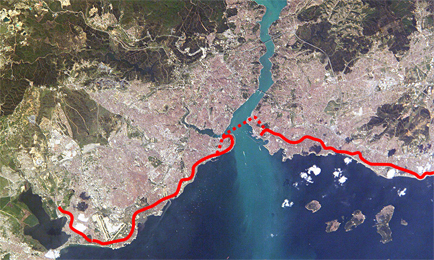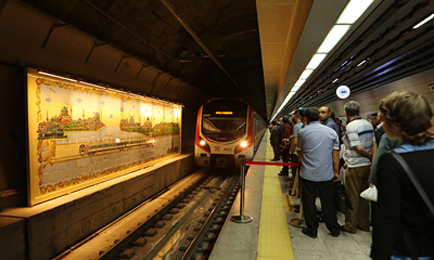Istanbul has always been the place where East meets West, the metaphorical crossroads of the World. But crossing compass points has never been straightforward in Istanbul. Travelling from one side of the city to the other - from Europe to Asia - requires crossing the Bosphorus Strait, a 3.4km stretch of water at its widest point.
Last October, 153 years after the idea was first proposed by a Turkish Sultan, engineers opened a rail tunnel under the Bosphorus. The Marmaray Tunnel is the only subsea rail link between two continents in the world. Locally, it’s relieving commuter traffic jams on the two bridges that span the Bosphorus. Internationally, it brings us a step closer to being able to travel seamlessly from London to Beijing on a single train.
The £3.4bn tunnel took ten years to build. It was four years late because of archaeologically significant objects and remains from the Byzantine-era found during construction. However, the first nine months of operation have gone without any major hitches, and this month the trains running through it are expected to double in size from five to ten cars. Each train will have a capacity of 3000 passengers, enabling a massive growth in passenger numbers.
 The Marmaray Tunnel runs under the Bosphorus at its most narrow point
The Marmaray Tunnel runs under the Bosphorus at its most narrow point
In total, the tunnel is 8.5 miles long. The immersed section is 0.9 miles long. Some 6.1 miles of tunnel was excavated using tunnel boring machines and 1.5 miles of tunnels dug from the surface using other techniques. The tunnel links to 39 miles of suburban railway, which is being upgraded as part of the project, and the initial project included the manufacture of 440 all-electric carriages. Construction was carried out by a Turkish-Japanese consortium consisting of the Taisei Corporation and and Turkish company Gama-Nurol. The rolling stock was supplied by Korean firm Hyundai Rotem.
Jean-Pierre Loubinoux, director general of the International Union of Railways, says: “This new link between Asia and Europe will facilitate the daily life of millions of people on both sides of the Bosphorus and will allow the passage of freight convoys along inter-continental corridors.
“A 153-year-old dream has come true and symbolises the extent to which governments have confidence in the railway system to improve the present and build the future.”
Despite the musings of Sultan Abdul Medjid, 19th century technology was not up to the task of putting a tunnel under the Bosphorus. Two centuries on, the engineering challenges are just as considerable. According to engineers from the consultancy Parsons Brinckerhoff, which designed the Marmaray Tunnel, the challenges involved led to the tunnel being known as one of the most difficult projects in the world.
The tunnel is situated extremely deep, 61m, in waters that contain powerful currents of up to six knots running in opposite directions. The Bosphorus Straits are relatively narrow but is used by more than 50,000 ships a year, around six an hour.
 Up to 45 million people are expected to use the undersea rail link this year, with ten car trains running at two minute intervals
Up to 45 million people are expected to use the undersea rail link this year, with ten car trains running at two minute intervals
But, perhaps most problematic is that the seafloor is located just 12 miles from the 745 mile long North Anatolian Fault zone. The region has suffered from severe earthquakes throughout history, notably in 1999 when an earthquake that measured 7.6 on the Richter scale killed 18,000 people. The ground the tunnel lies in is also at risk of liquefaction, a phenomenon where seismic activity causes soil to soften. This can cause underground structures to move and sometimes float to the surface.
The immersed part of the tunnel is therefore be built to withstand earthquakes up to a magnitude of nine on the Richter scale. All the new stations and tunnels are also built to remain operational after an earthquake of 7.5 moment magnitude, a more modern and precise scale than the Richter scale.
A further complication is that the ends of the immersed section of the tunnel had to be connected in deep water to four different tunnels that were excavated from the surface using tunnel boring machines. In addition, the tunnels are larger than most rail tunnels and the trains larger than average trains.
The immersed tunnel was built in eleven sections: each roughly 135m long, 15.3m wide and 8.6m high and weighing about 18,000 tonnes. The tunnel is a rectangular concrete box, with a separate tube for each track direction. It is wrapped in a thin steel membrane with a plastic membrane at the top to provide extra waterproofing. A steel “end shell” at the end of each tunnel section enclose the bulkheads and supports an immersion joint, GINA gasket and its contact plate. These steel and rubber gaskets enable the structure to flex without breaking.
The seismically unstable areas were overdredged and replaced during construction. Areas identified as liable to liquefy during seismic activity were also treated with compaction grouting to a depth of up to 8m. This process involved drilling almost 3000 holes into the sea bed and injecting 8m columns of grout into the holes from a drilling barge.
A forecasting system to identify low currents was developed by the contractors to assess when the windows of opportunity for construction re, using the differences in water levels at either end of the Bosphorus. Careful coordination of the shipping lanes was also conducted with the relevant authorities to limit their closure to when immersion activities were taking place.
The first section of the immersed tunnel was sunk into place in 2007, three years after construction started elsewhere on the project. The end shell structures and steel membranes were added into the tunnel sections in dry docks. Each segment was fitted with temporary bulkheads to allow them to float while the insides remain dry. They were then independently towed out to sea and sunk into the previously excavated trench.
Jacking frames and guides at the ends of each section were used to accurately adjust each section to enable the sections to be joined. A porous gravel foundation “blanket”, designed to prevent liquefaction directly under the tunnel, was placed at the bottom of the trench. After reinforcement with grout, this foundation also supports the tunnel section when the frames were removed.
The sections were joined by by extending a jack arm from the tunnel already in place to the element being installed, retracting it to compress a soft nose on the GINA gasket, then pumping the water out of the joint to mobilise the unbalanced force of water pressure to fully compress the GINA. In this way, each joint was entered and cleaned, the bulkheads removed, and the joint space completed as the tunnel progressed across the Bosphorus. As the ballast tanks were removed from each element, their weight was replaced with concrete permanent ballast in the invert. The trench and tunnel were then backfilled to a minimum level of 2m.
The signalling and train control system was installed after the tunnel was completed and the rails had been laid in just two months by Siemens Rail Automation. A moving block system was used to enable trains to travel through the tunnel at two minute intervals.
A Trainguard Sirius CBTC control system installed in the infrastructure and trains collects information concerning the location of individual cars. As the train moves through the tunnel, it reports its position via wireless communications and processors connected to the electronic interlockings. The trains receive instructions telling them how fast they can travel in which blocks, while balises, plates equipped with transmitters and receivers and embedded in the tracks, register position and speed. Each train is automatically adjusted to the speed and position of the others.
Engineer Javier Raposo, from the team at Siemens Rail Automation, says: “The crucial feature of our train control system is that it knows what conclusions must be drawn on the basis of the information. It always knows how fast each train is traveling, when it stops, and when it starts up again. It knows the positions of the individual trains, and it recalculates the driving speed and braking distance for all the CBTC trains that are on a given route. The driver authorises the train to run in automatic mode after each stop at a station and supervises the closure of the passenger doors.”

The train control system and trackside equipment was installed in just two months after the tunnel and track were completed
Protection against earthquakes is also built into the system. Sensors are designed to trigger an alarm if the earth quakes or water begins seeping into the tunnel, automatically stopping the trains before entering the immersed section of the tunnel. The system is also designed to close floodgates at both ends of the affected tunnel section. Raposo says: “The train control system also knows whether there are still trains in the section. The gates close only after all trains have left this critical section.”
Some 45 million people are expected to take the 5 minute trip under the Bosphorus Strait in the Marmaray Tunnel this year. They will barely notice the earthquake-proof tunnels and advanced signalling system or realise the years of engineering design and construction effort that went into linking two continents by rail for the first time.